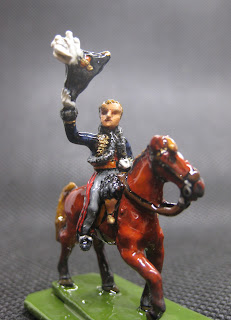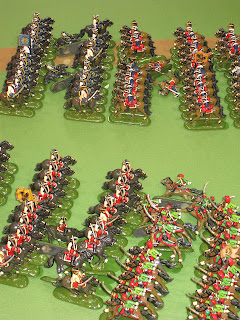John came round today for the next round in our Chain of Command learning campaign - the push by my platoon from the 5th Wiltshires to take the Normandy village of Maltot in 1944. The previous 3 games are covered in an earlier post.
Both our platoons were now seriously understrength (approximately one full section and others reduced to LMG teams). Despite this, we both elected to press on, saving our one-off reinforcement option for another day.
This scenario saw the British attacking the main defence position of the Germans and was more built up than previous games - providing good defensive positions but also some covered approached for the British. The patrol phase saw the German jump off points (JOPs) clustered in three buildings in one corner of the table facing the large farm building holding one of the British JOPs (see below)
The Germans chose fairly passive support options, 2 minefields and 2 barbed wire entanglements, which can be seen in the above photo; their last support point being spent on an adjutant to chivvy their troops onto the table.
The British (having a starting morale of 9 versus the German 8) took the first move and immediately established a strong firebase with a section of two Bren (LMG) sections placed on overwatch upstairs in the large house. Their best section (only one man short of establishment) entered from a JOP placed further back together with the 2" mortar (once again placed under the control a redundant section leader). The photo shows these troops arriving and the location of the other two British JOPs (white stars).
The Germans responded by deploying a section (really just a reinforced MG42 team) into the house with a grey tile roof adjacent to the road running through the middle of the table. In following British phase I deployed my key support elements, a Churchill Mk IV, and a forward observer (FO) for an off-table 3" mortar battery, with my platoon sergeant, into the large farmhouse.
This seemed to spook the Germans into deploying another section into the same house (one upstairs and one downstairs).
In the next British phase, while the FO established contact with the 3" mortar battery, the Churchill edged forward and put a round into the house holding the two German sections (to no effect) and the British section, who had been joined by the platoon leader, advanced further as though 'left flanking'. The 2" mortar also placed some smoke in front of the German occupied house.
To counter the nascent flanking move the Germans sent one of their 'sections' across the road, through the British Smoke, to occupy the white house (with the badly shot up render). At the same time their senior platoon leader deployed behind the smallest building holding a German JOP, why I don't know.
This early deployment by the Germans, probably an overreaction to their experience deploying after a pre-game barrage in the previous games, was to prove their undoing. But not until after they had a triple phase that saw their MG42 team taking cover behind the wrecked lorry to fire at my advancing section. However, in a breathtaking series of unlucky dice throws, all three rounds of German firing only inflicted 2 shock on my section.
In my next phase the British flanking platoon decided not push their luck and pulled back behind the barn. This allowed the FO to call in a barrage from their 3" mortar battery. The FO dispensed with an aiming shot, calling in an immediate barrage which luckily landed on target first time! The outer edges of the barrage, which extends off table beyond the German baseline, are marked by lengths of smoke in the photo below.
This barrage pinned the German section in the JOP house next to the road and also just caught, and pinned, their platoon leader behind the derelict outhouse.
The barrage was to prove frustratingly ineffective in terms of killing anyone, but left the Germans in a really sticky situation with the only section not pinned by the barrage stuck in the road. It couldn't go back because of the barrage and entering the house would see it subjected to fire from the Churchill to which it could not reply.
The action then slowed to a steady drumbeat of tank fire and mortar rounds with the Germans hunkering down (mostly in hard cover) and hoping to win the battle of the CoC dice. Eventually, they did win, courtesy of a double, and then a triple phase, including an end of turn (three 6's). This left me out of CoC dice to keep my barrage going when he used his third(!) CoC dice to end it. As soon as the barrage ended, the German platoon leader, again for reasons I couldn't fathom, fled to the table edge furthest from my troops - he can be seen in the foreground of the image below, cowering behind a hedge.
My FO's attempt to request another barrage, first met with a response to 'try again later' and then, later, with a blunt refusal to provide any more fire support during this action.
The dice then came to my rescue, BIG TIME! First a double phase that saw my tank achieve 4 hits on the white house, all of which generated shock and pinned the team inside (it had already had a point of shock and was weak having earlier lost 1 man). Seizing the opportunity my platoon leader who had earlier joined the 'flanking section' doubled them towards the house and removed the resulting shock. The very next phase, also being mine, saw the tank being unable to fire but the platoon leader was able to repeat his advance at the double. The next photo, the only posed photo, shows the section strung out indicating the extent of their second advance (they were closed up with the leading figures after the photo was taken).
Lady Luck, belying her fickle nature, stayed true to the Brits denying the Germans any Coc Dice that could rally the pinned occupants of the white house.
Consequently, in the next phase my section advanced up to the house to post a couple of grenades through the window. A slight hitch occurred when a 'double 1' was thrown and the first grenade was dropped at their feet. But in stepped Lady Luck again to limit the damage to just 2 shock. The next grenade sailed through the window with ease and promptly killed the rest of the LMG team-cum-section.
A discussion then ensured as to whether or not the surviving junior leader should rout, as while the shock now exceeded the number of figures all his men were dead and leaders do not take shock. Surprisingly, John thought he should rout and I thought the rules implied he should not, albeit that in reality it seemed unlikely he would hang around. Anyway, we went with the rout option so he fled off the table - see below. [If anyone knows what we should've done do tell.]
With the German force morale about to start shedding command dice, John decided it was time to call it a day and withdraw.In case anyone has done the sums and wonders why the Brits seem short of support, I did have a mine-clearing team. They never got involved as John didn't deploy his minefields across the roads to stop my tank entering, although they did deploy into the large farmhouse with the 2 Bren teams.
The butcher's bill for this game was 5 dead German riflemen (no leaders lost or wounded) and ZERO BRITISH CASUALTIES!
The state of the two platoons for the next game (scenario 4 of 5) is now:
British strength: 2 Senior Leaders, 3 Junior Leaders, and, 17 men to operate the PIAT, 2" mortar, 3 Bren LMGs and provide any rifle teams.
British casualties: 14 permanently lost[1].
German strength: 1 Senior Leader; 3 Junior Leaders; and, 16 men to operate the Panzerschreck; and, 3 MG42s and provide any rifle teams[2].
German casualties: 11 permanently lost and 2 wounded men due to return after the next game.
Notes:
1. You might've noticed something odd with the British casualty recovery as they shouldn't get any troops returning after missing a game. As we didn't know how the error had occurred we stuck with it and let the returning soldier (see the last CoC post) rejoin his unit.
2. The 4 Germans returning after being wounded in game three together with one immediately returning to duty from this game sees the German platoon strength unaltered.
Again! I'll try and take more photos next time, but I find these rules so engrossing I just get sucked in.



.jpg)







































